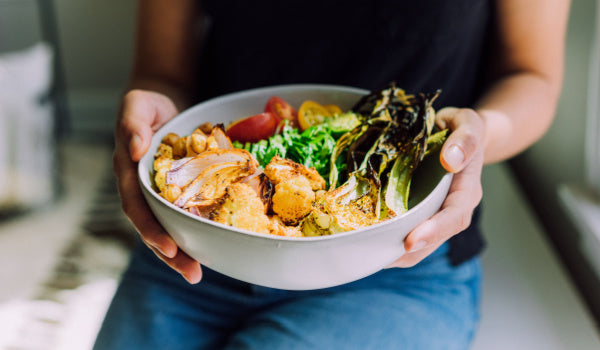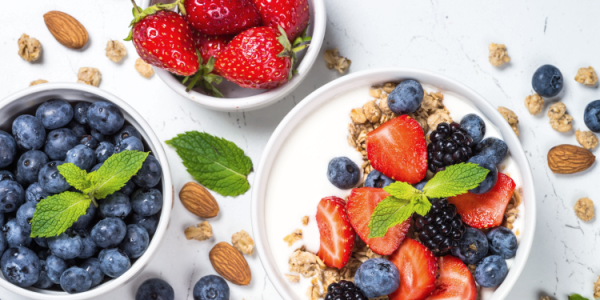
Searching for excellent sources of plant-based protein that also keep carbs low can seem like a challenge, especially when you’re starting out. Some great sources—like nuts and seeds—are obvious, while others are slightly more sneaky.
Luckily, you don’t have to be on a plant-based diet or vegetarian diet to appreciate the versatility of non-animal protein. Keep reading for the ultimate list of plant-based foods rich in protein content, including top picks for low-carb diets.
What Are Plant-Based Protein Foods?
As the name suggests, plant-based foods are those that come from plants. This term, understandably, includes a wide array of minimally-processed plant foods, including:
• Fruits and vegetables
• Legumes
• Whole grains
• Nuts and seeds
• Herbs and spices
It’s important to keep in mind that just because a food is plant-based doesn’t mean it’s “healthy.” Technically, cane sugar is plant-based, but copious amounts of sugar in the diet can be concerning when it comes to health. However, on average, plant foods are higher in nutrients the body needs.
Plant foods tend to have a more balanced macronutrient profile, typically containing more proteins and quality carbohydrates—at 4 calories per gram—and less fat—at 9 calories per gram. This is in stark contrast to animal-based proteins, even lean sources like chicken for example, which are predominantly protein and offer a few select vitamins and minerals.
Not only are plant-based foods generally higher in fiber and healthy fats, but they also contain increased amounts of potentially healing compounds like phytonutrients and antioxidants. They are plentiful in micronutrients, which are the vitamins and minerals needed for optimal body functioning.
Looking to increase plant protein intake? The following foods are good sources of protein, for casual plant eaters and low-carb vegan dieters alike.
*= Complete protein or “nearly complete” proteins, meaning they contain all or most essential amino acids
Legumes
Legumes—like beans, lentils, and peas—are considered an inexpensive source of protein, vitamins, complex carbohydrates, and fiber.
Beans
Beans are a type of legume that can be especially high in protein while staying relatively low in net carbohydrates (“carbs”), thanks to high fiber content. For example, a cup of black beans has 12-15 grams of protein while keeping carbs around 20 grams.
Foods like green beans and chickpeas make a great side dish while still being considered low on the glycemic index for those looking to balance blood sugar or lose weight.
Although incomplete proteins on their own, beans pair exceptionally well with many other foods. In foods like vegan chili, they provide a hearty texture. They are a staple in many diets and cuisines, such as Mexican food.
Lentils
Think beans are high in protein? They are, but lentils offer even more with a whopping 17 grams per cup! Well-utilized in Eastern cuisines, lentils come in various colors and are perfect for bulking up meals.
Peas
Pea pods are another legume, which contains pulses called peas, that add protein to the diet. Along with many vitamins and minerals, a half cup of peas contains about 8 net grams of carbs and 4 grams of protein. Other than the green pea, there are many varieties of edible pea pods and peas to explore.
Enjoy snap peas as a snack or green peas as a side dish. In a hurry? Frozen peas can be heated quickly and enjoyed as a last-minute dinner side dish, stir-fry ingredient, or soup add-in.
Nuts & Seeds
Nuts and seeds might be tiny, but they are nutritional powerhouses in terms of healthy fats, plant-based protein, and essential micronutrients like vitamin E.
Nuts & Nut Butters
Both nuts and nut butters can fit into a low-carb diet while providing plenty of protein. Interestingly, nut pastes were made anciently by Incan and Aztec communities. However, it wasn’t until the early 1900s when peanut butter was introduced at the World’s Fair that nut butters really gained popularity.
Peanut butter is so high in protein that one story of origin is that it was used as a more palatable protein supplement for hospital patients in the late 1800s and early 1900s. It was also used as a source of protein for the Armed Forces in World Wars I and II. In other words, it’s been believed to be a natural form of nutrition therapy for certain populations.
Although peanuts are technically a legume, they are included as part of the nut family. Other nuts are nutritious, too, and contain lots of healthy fats! Particularly protein-packed, low-carb options include:
• Almonds (and almond nut butter)
• Brazil nuts
• Pecans
• Walnuts
Chia Seeds*
Chia seeds are well-loved for their versatility. Not only do they provide 5 grams of protein per ounce, they can be used in almost any meal.
Use them in morning smoothies, toast and sprinkle atop a salad, or add to bulk up casseroles and other grain dishes. As an egg alternative, add to water (in a 1:3 seed-to-water ratio, e.g. 1 Tbsp seeds to 3 Tbsp water) to make a vegan egg replacement for baking.
Hemp Seeds*
Surprisingly, hemp is considered one of the most nutritionally complete foods and is an excellent source of protein. Just 1 ounce of hemp seeds contains nearly 9 grams of protein and less than 2 grams of carbs.
Plus, hemp seeds are naturally low in saturated fats and contain plenty of “healthy” fats like unsaturated and omega-3 fatty acids.
Soy Foods
Whether soy is healthy or unhealthy is often questioned, though most research suggests no definitive reason to avoid it completely. Especially when consuming whole food sources, soy is packed with plant protein and other valuable nutrients.
Whole Sources of Soy*
Whole sources of soy, such as the following, are also protein-packed:
• Miso
• Tempeh* (made from fermented soybeans)
• Tofu* (made from curdled soy milk)
Tofu and tempeh are especially protein-rich, offering 7 and 15 grams (respectively) per 3 ounce portion. Commonly, they provide a natural vegan replacement for a 3 oz portion of animal meat.
Plant-based beverages and dairy alternatives—such as soy milk—can also count as sources of protein for a plant-based diet. In fact, when compared to other plant-based milks, soy milk offers the amount of protein closest to cow's milk.
To ensure you’re getting nutrients, seek fortified soy products. For instance, soy-based yogurts with probiotics or soy-based beverages with vitamin D and calcium added.
Edamame*
Edamame is eaten as an immature soybean pod, squeezed from the pod, and often enjoyed with a simple sprinkling of salt. Along with other soy foods, edamame provides an exceptional amount of protein. With nearly 17 grams per cup, edamame makes a perfect snack and is a good source of iron for vegans.
Protein is a nutrient crucial to keeping you feeling full. Since edamame has plenty of protein, it’s great alongside a midday lunch or as part of a salad. It’s also considered a whole or complete protein source, meaning it provides all the amino acids (building blocks of protein) that your body can’t produce on its own.
Whole Grains
Sticking to whole grains—like oats, bulgur, and wild rice—nourishes the body with fiber, protein, B vitamins, and so much more. Plus, they’re simple to use!
Oats
Although it may seem like a boring morning meal, oats are actually incredibly healthy and fuel for the body. A single cup of oatmeal contains 4 grams of protein and can become even more protein-packed with add-ins like ¼ cup of nuts, 1 tablespoon of nut butter, or a scoop of plant-based protein powder.
Compared to refined grains, oats as whole grains are low in carbs. Thanks to their fiber content, 1/2 cup of oats has about 15 grams of net carbs.
Bulgur
Bulgur often ranks at the top of whole grain lists, not for alphabetical reasons. It’s very versatile, and can be made sweet in a sort of porridge or savory when mixed with vegetables.
A beloved grain, bulgur contains under 15 grams of net carbs per ½ cup serving. This makes it a low-carb side dish or base for many types of meals. With 3 grams of protein per ½ cup, it’s also a protein-packed addition to your plate.
Buckwheat*
Buckwheat is often used as a grain alternative on low-carb diets, even though it contains many carbs. This is due to its unique nutrition profile since it contains more fiber and fewer natural sugars than other types of grains.
A ½ cup of buckwheat contains about 17 grams of carbs. A cooked ½ cup contains about 3 grams of protein, too. What really makes buckwheat stand out as a plant food is it’s complete amino acid profile, which offers all the essential protein “building blocks” the body can’t make on its own.
Quinoa*
Quinoa is a popular gluten-free whole grain that is rich in protein. Per ½ cup serving, quinoa contains nearly 4 grams of protein and around 9 grams of net carbs.
Like oats and bulgur, quinoa can be enjoyed as a sweet or savory dish. Combine it with beans in a salad for a vegetarian, high-protein meal!
Wild Rice
While brown rice usually gets all the attention, wild rice is considerably low in carbs and contains about 4 grams of protein per ½ cup when cooked. It’s a great alternative to white rice if you watch your weight. It also has a more noticeable flavor and adds a unique texture to afternoon or evening meals.
Seitan
Affectionately referred to as “wheat meat,” seitan is made from the main protein of wheat, which is gluten. It can be made of whole wheat flour or an ingredient called vital wheat gluten.
Although seitan is made from components of grains, it is actually a great meat alternative to use instead of textured vegetable protein (TVP). Naturally, seitan is high in protein (around 45 grams per half cup), which makes it a popular vegetarian meat substitute.
Due to its mild, neutral flavor, it easily takes on a variety of seasonings and spice blends. It is used in similar settings as tofu and tempeh.
Pasta
Think you should eliminate pasta to be “healthy?” Think again! Various forms of pasta can absolutely fit into a balanced diet and provide protein, fiber, and vitamins plant-based dieters are at risk of being deficient in.
Couscous
Although often mistaken as a whole grain, couscous is actually a type of tiny pasta. It’s a well-known component of anti-aging and anti-inflammatory diets, thanks to its selenium content. Selenium acts like an antioxidant in the body, which helps to prevent damage at the cellular level.
In terms of protein and carbs, couscous is also a health-conscious choice. In a ½ cup serving, couscous contains 17 net carbs and about 4 grams of protein.
Protein-Enriched Pasta
Thanks to the rise of veggie- and legume-based pasta, your favorite Italian dishes can now be made low-carb. For protein-packed pasta, seek out spinach, chickpea, or lentil-based varieties.
Pasta can be an especially nutritious dish when you combine it with protein-rich veggies, like spinach or broccoli. Although cheese adds protein, keep carbs low by using nutritional yeast to create a cheesy flavor. As a bonus, nutritional yeast is fortified with B-vitamins, which vegans and vegetarians may be deficient in.
A Final Word on High-Protein, Plant-Based Foods
Contrary to popular belief, food doesn’t need to be animal-based to be considered a protein powerhouse. Plant foods pack plenty of protein into your diet, while also offering vitamins, minerals, healthy fats, fiber, and more.
What’s not to love? While some plant foods are complete proteins on their own, you can also combine low-carb, high-protein foods together for a nutritious dish.
References
Bob’s Red Mill. What Is Seitan, and Is It Healthy? Bobsredmill.com. Published August 2021.
Cleveland Clinic. What Are Complete Proteins? Health.clevelandclinic.org. Published December 2022.
Fardet A. 16- New Concepts and Paradigms for the Protective effects of Plant-Based food Components in Relation to Food Complexity. In: Fardet A, ed. Vegetarian and Plant-Based Diets in Health and Disease Prevention. Academic Press;2017:293-312.
Filip S, Vidrih R. Amino Acid Composition of Protein-Enriched Dried Pasta: Is It Suitable for a Low-Carbohydrate Diet? Food Technol Biotechnol. 2015;53(3):298-306.
Harvard Health Publishing. Legume of the month: Peas. Health.harvard.edu. Published October 2019.
National Peanut Board. History of Peanuts & Peanut Butter. Nationalpeanutboard.org. Accessed May 2023.
Ostfeld RJ. Definition of a plant-based diet and overview of this special issue. J Geriatr Cardiol. 2017;14(5):315.
Valdez J. Buckwheat Nutrition Facts and Health Benefits. Verywellfit.com. Published July 2020.
Wolfram T. Vegetarian Glossary of Terms. Eatright.org. Published October 2017.







